Kia has a habit of making clever variations on the products of its sister company, Hyundai. Hyundai recently launched the Ioniq hatchback in hybrid and EV forms. Kia's variant, the Niro, is only offered as a hybrid, but is a few inches taller, enabling it to pass a a crossover. Plus the cleanly styled Niro bears more than a passing resemblance to an upscale Audi. But its price is much lower than an Audi's. Could this be a winning formula with broader appeal than any other hybrid to date?
Initially the Niro's combination of attributes struck me as unique. But there are two other hybrids with similar proportions, the Ford C-MAX and Toyota Prius v. Plus both Nissan and Toyota now offer their compact crossovers, the Rogue and the RAV4, with hybrid powertrains. Does the Niro really offer something none of these do?
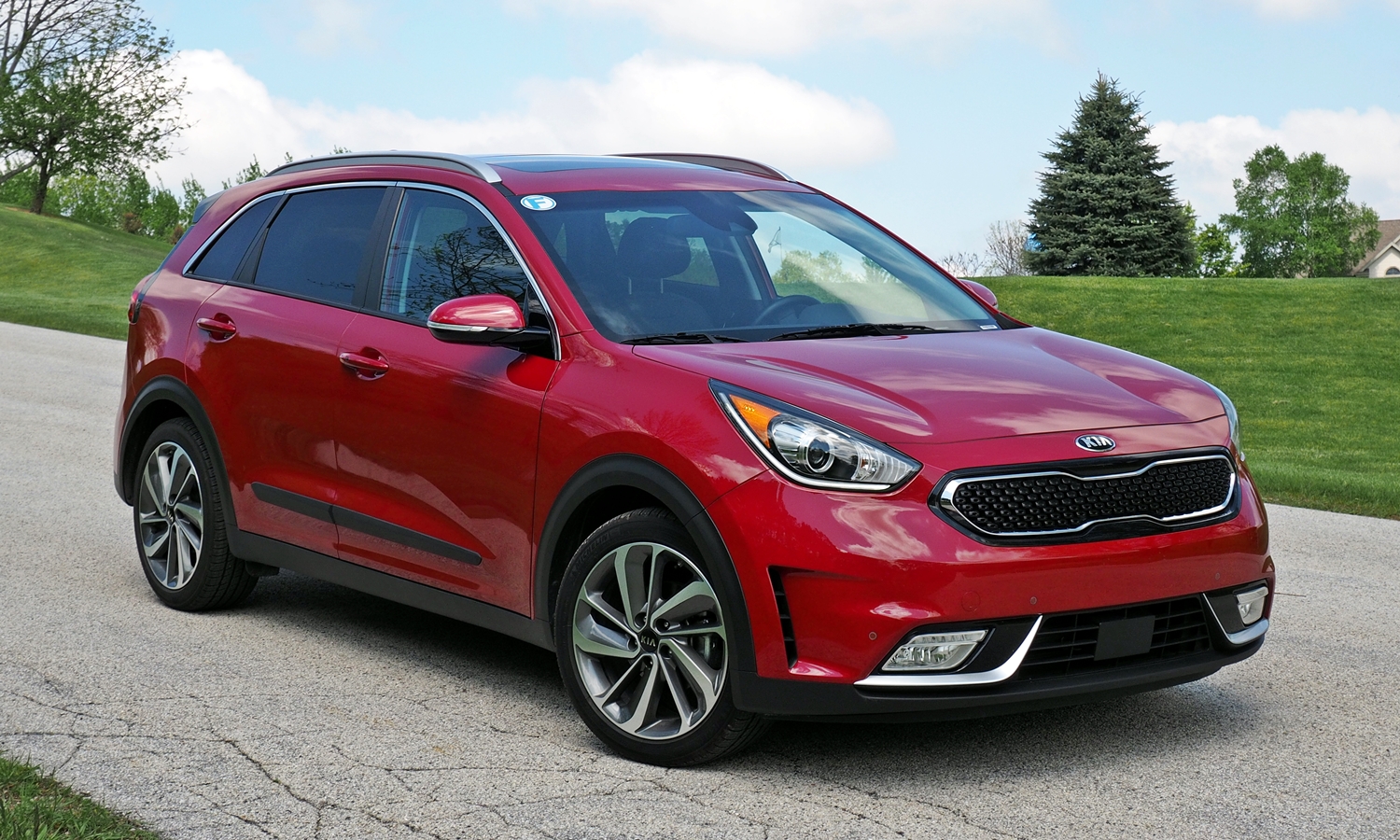
Handsome lines with a hint of Audi. Just enough height to pass as a crossover. more Niro photos
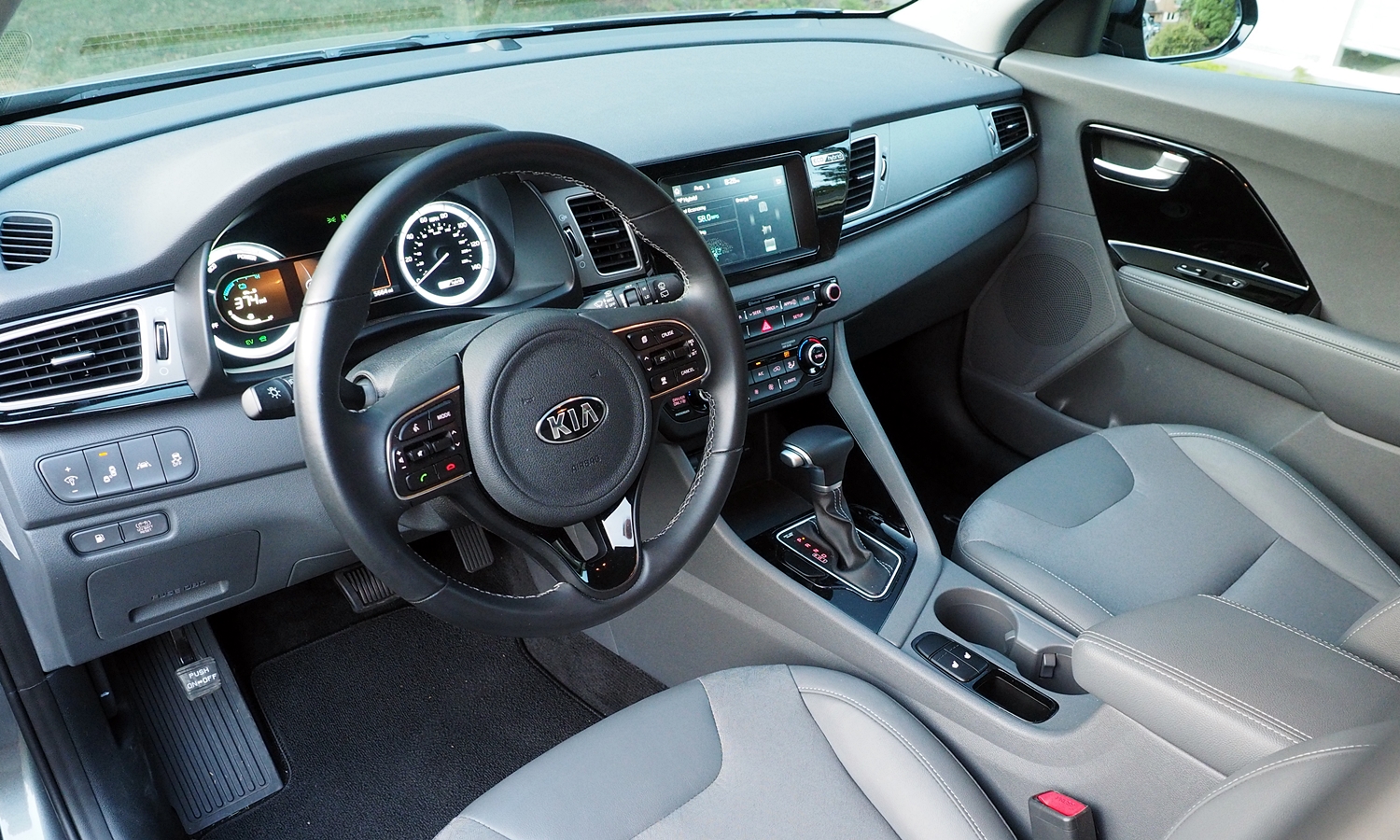
Tastefully styled interior. Comfortably padded armrests. EX has combination of leather and cloth.
| |
Compared to the RAV4 |
| Fuel economy |
 Better
Worse
Better
Worse
|
With EPA ratings of 51 mpg city and 46 mpg highway, the Kia Niro lags the related Hyundai Ioniq hatchback (57/59), especially on the highway, but easily tops other tall hybrids:
Toyota Prius V 44/40
Ford C-MAX 42/38
Nissan Rogue FWD 33/35
Nissan Rogue AWD 31/34
Toyota RAV4 AWD 34/30
In my suburban driving the trip computer averages ranged from 40 to 80 depending on how much of the drive was spent in EV mode, drawing from the small battery pack. On longer drives where this cheat wasn't possible 65 mpg was fairly easy to achieve. On a 70-mph highway the Niro averaged 57 mpg in one direction and 37 mpg in the other. Oddly, running the A/C didn't seem to make much difference. On one 57-mile drive that was a little over half highway with the ambient temperature in the 80s and the A/C running the Niro used a single gallon of gas. Impressive.
In the Ford C-MAX I averaged about 37 mpg in suburban driving, with just some trips over 40 mpg. The best I could get out of the Toyota RAV4 hybrid was 38 mpg. I observed trip averages in the 90s in the regular Prius, though.
| Exterior styling |
 Better
Worse
Better
Worse
|
Neither the Ford C-MAX nor the Toyota Prius v is an attractive car. Both suffer from ungainly proportions and odd design choices. In comparison, the Kia Niro appears far more stylish, with more than a hint of Audi and even of Porsche crossovers. There's nothing racy here. Just a somewhat upscale, somewhat sporty look that should have broad appeal.
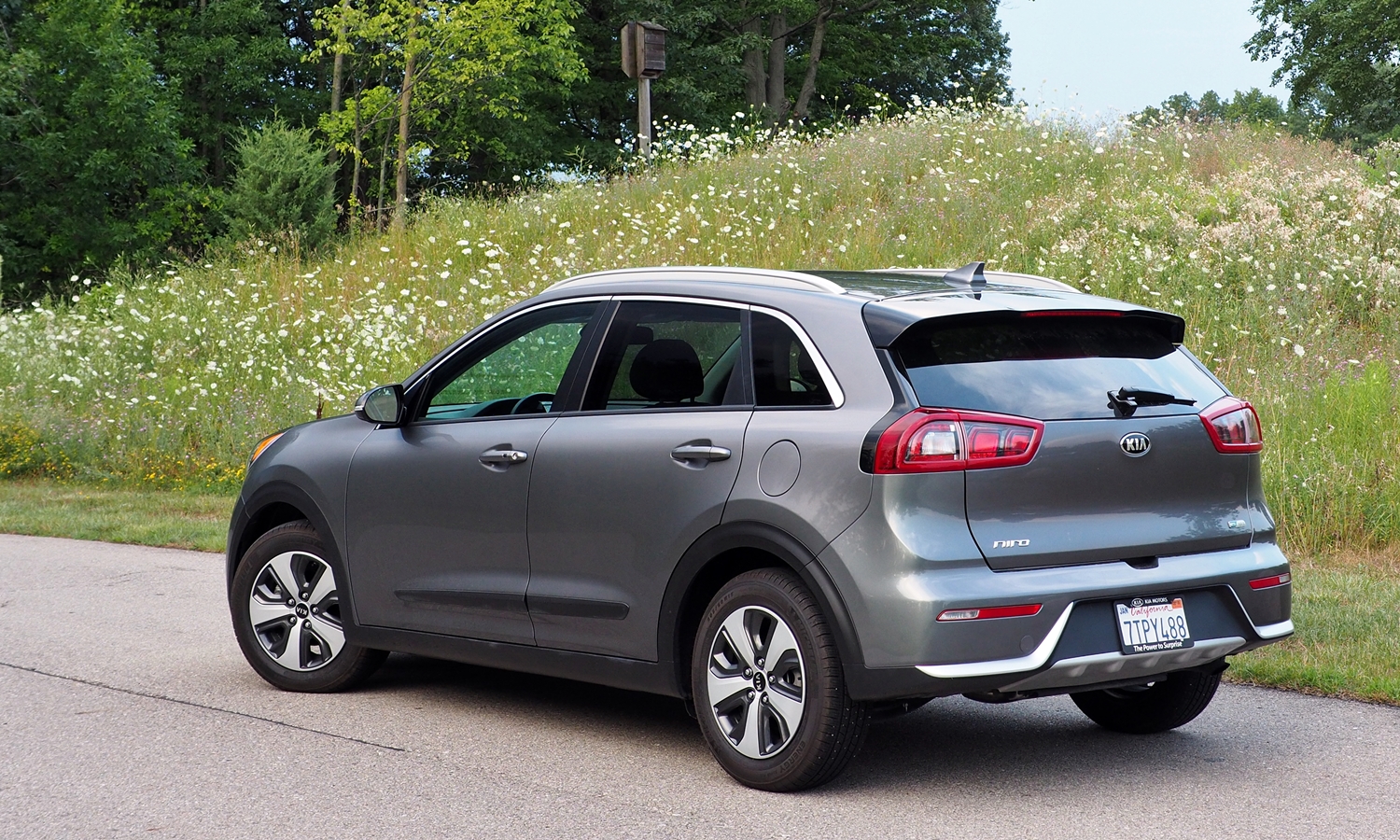
Rear end design puts style ahead of functionality. Black wheel lip trim says crossover.
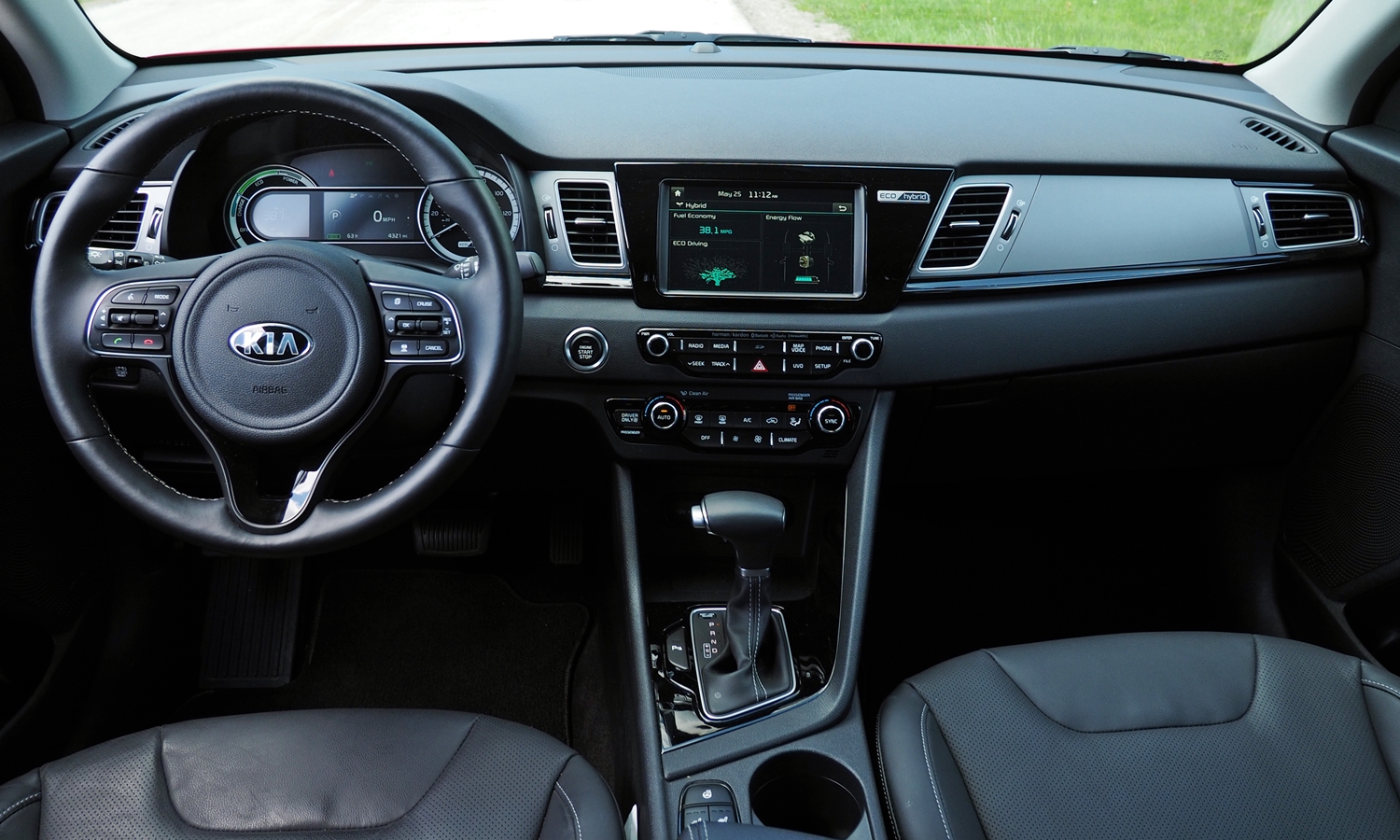
As in other Kias, simple, thoroughly conventional, easy to use controls.
| Price or payments |
 Better
Worse
Better
Worse
|
Pricing for the Kia Niro ranges from $23,785 to $32,445. The tested Niro EX with the Sunroof and Advanced Technology Package (adaptive cruise control, forward collision warning, lane departure warning, power driver seat) lists for $28,895. With the Toyota Prius v, you can only get adaptive cruise control and a sunroof on the top trim level. Partly for this reason a Prius v with these features lists for a substantial $6,355 more than the tested Kia. Adjusting for feature differences narrows this gap by only about $650. Even comparing base models the Prius v starts $3,775 higher despite having less standard content.
The Ford C-MAX is much closer in price to the Niro--if you go light on the options. A C-MAX SE lists for $1,380 less than a Niro EX, but the latter includes about $1,000 in additional features. Adjust for these and the difference is only a few hundred dollars. Want blind spot warning or a glass roof panel? (You cannot get an opening sunroof or adaptive cruise control on the C-MAX.) Then you're forced into the top trim of the C-MAX, and the Niro (which offers these features on the mid-level EX) ends up thousands less. Load both up and the C-MAX lists for $570 less but the Niro includes about $1,300 in additional content.
But what about the related Hyundai Ioniq hatchback? Crossovers tend to cost much more than similarly sized hatchbacks. Not in this case: the Kia is priced similarly to the Hyundai.
So far the Niro looks like a good value. But then there's the Toyota RAV4 Hybrid XLE, which lists for only $1,095 more despite being a much larger vehicle with standard all-wheel-drive. Adjust for feature differences and the two cars are priced almost identically. Given the Niro's far better fuel economy, the two don't directly compete. But Prius v sales plummeted when the RAV4 Hybrid was introduced as a 2016 model, so there appears to be considerable cross-shopping between the RAV4 Hybrid and hybrids the size of the Niro.
| Driving position & visibility |
 Better
Worse
Better
Worse
|
As in the Ford C-MAX, in the Kia Niro you sit higher than in a car but lower than in a typical crossover like the Toyota RAV4. For many people this moderately high seating position will be just right.
Unlike in the C-MAX and Toyota Prius v, the view forward doesn't suggest that in a minivan. Instead, the relative position and depth of the Kia Niro's instrument panel are much more conventional, with absolutely nothing that might be off-putting about them.
| Rear seat room & comfort |
 Better
Worse
Better
Worse
|
The Kia Niro's compact exterior dimensions somehow contain plentiful headroom and legroom in both rows. Beyond the measurements, the rear seat is positioned at an unusually comfortable height, affording both excellent leg support and an open view forward over the front seats.
| |
Compared to the RAV4 |
| Feature availability |
 Better
Worse
Better
Worse
|
The Kia Niro offers a full array of collision avoidance tech on all but the lowest trim level. Unlike with some competitors, you can also get a sunroof and heated front seats without stepping up to the top trim. If you do step up to the Touring, the front seats are also ventilated and the steering wheel can be heated.
But there are some major features you cannot get. While the Niro has the styling of a crossover it is not offered with all-wheel-drive. And while the related Ioniq is offered as a pure EV with stronger yet silent acceleration (I enjoyed driving it much more than the Ioniq hybrid), the Niro isn't offered as a pure EV. A plug-in hybrid will be offered for 2018, but its electric motor won't be nearly as strong as the Ioniq EV's.
| Cargo capacity |
 Better
Worse
Better
Worse
|
A lack of AWD isn't the only way the Kia Niro can't directly compete with conventional crossovers. It also cannot hold nearly as much cargo. While the compact exterior dimensions don't appear to harm passenger room, they do make for much less space than in a Prius v or RAV4 behind the rear seat.
Compared to that of the Niro, a RAV4 hybrid's cargo area is six inches taller, three inches widers, and five-to-ten inches longer (depending on whether you're measuring at the midpoint or the outside). In the official specs this translates to about 20 more cubic feet of cargo volume (38.4 vs. 19.4 with the rear seat up and 73.4 vs. 54.5 with it folded). The Prius V can also fit more cargo (34.3 cubic feet with the seat up and 67.3 with it folded). The C-MAX has less of an advantage, though (24.5 cubic feet with the seat up and 52.6 with it folded).
Even the Ioniq hatchback can carry more cargo thanks to its longer rear overhang (26.5 cubic feet with the rear seat up).
While the cargo space in the Niro is probably enough for most people nearly all of the time, there's another limitation. The cargo mat states "160 lbs. max." If you have heavy items to carry you'll want to use a different vehicle.
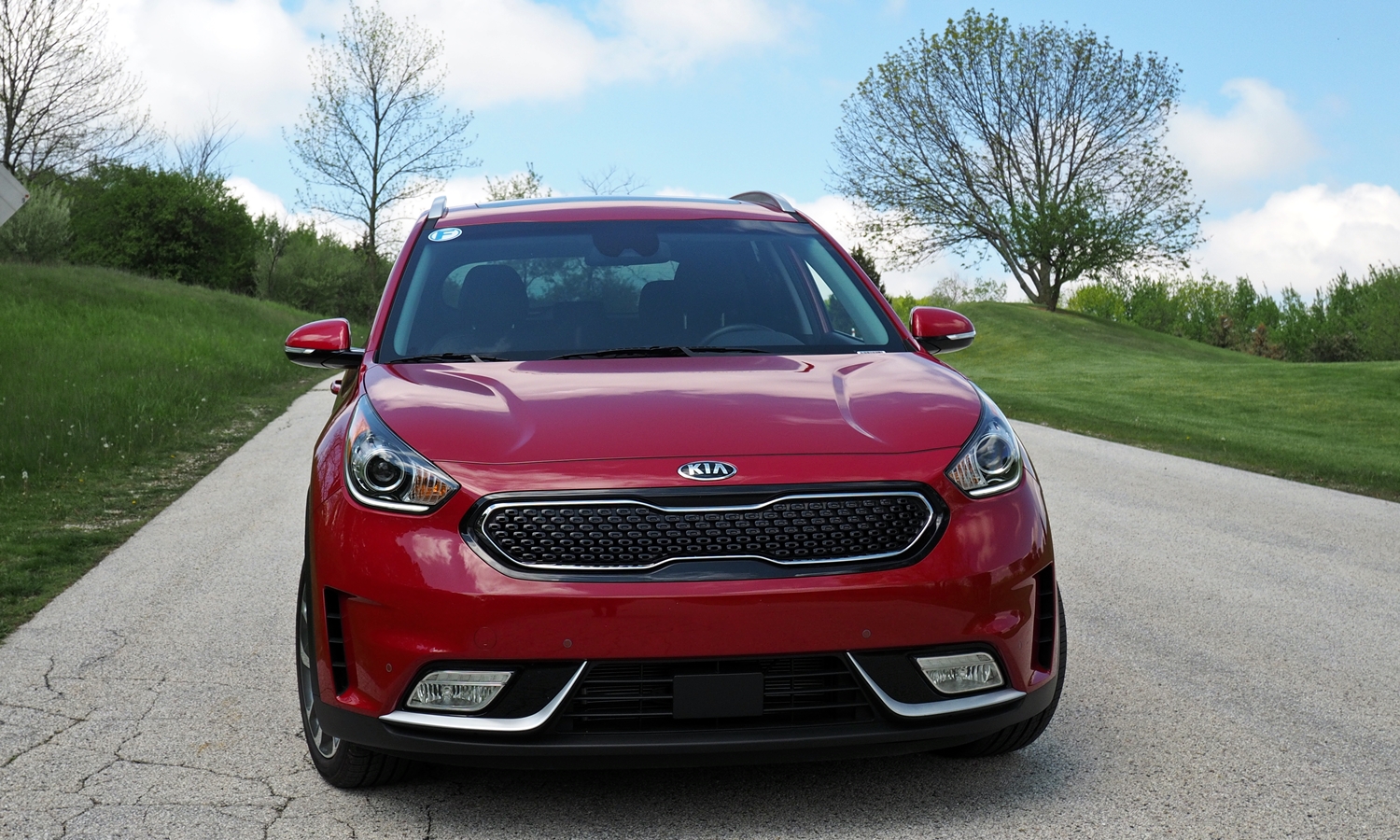
Stylish but not funky front end. Crossover height. Current Kia grille.
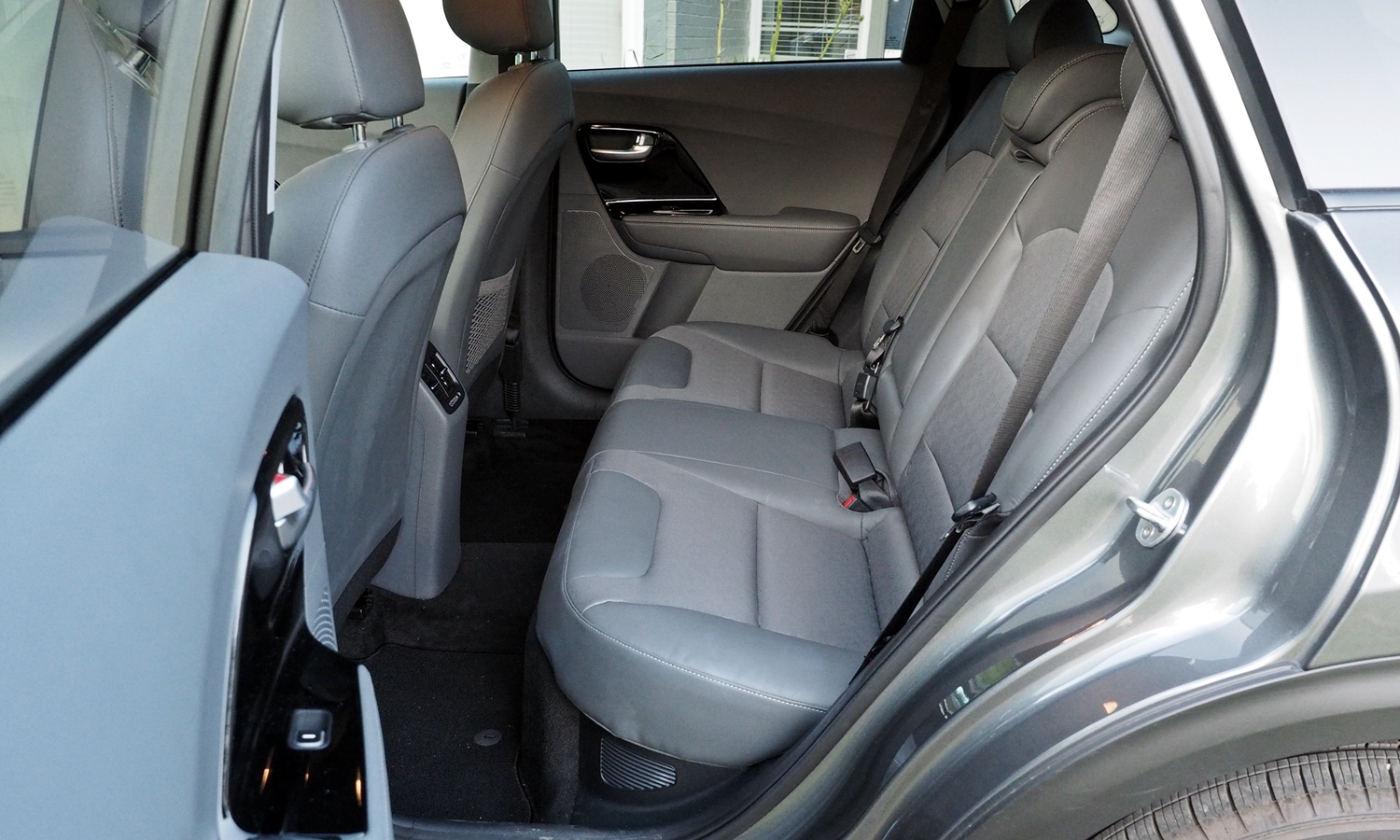
Plenty of headroom and legroom in back. Plus a comfortably high cushion.
| |
Compared to the RAV4 |
| Powertrain performance |
 Better
Worse
Better
Worse
|
Drive to keep the efficiency indicator in the eco range, and the Niro accelerates slowly. A Prius is even more sluggish, but this won't be much of an excuse for the people trapped behind you. Sacrifice fuel economy to keep up with traffic, and the Niro's engine delivers, but with a fair amount of racket. (The electric motor isn't strong enough to accelerate the car on its own except very slowly at low speeds.) The C-MAX's powertrain, with a larger gas engine and a more powerful electric motor, seems less strained, though the C-MAX is not significantly quicker than the Niro. Both are significantly quicker than the Prius v--but not quite as quick as the RAV4 Hybrid.
Engaging the Niro's sport mode with the shift lever dramatically increases throttle response and enables manual shifting. You won't want to drive in sport mode all the time, though, as the transmission then holds a lower gear even when there is no need for this.
One advantage the Niro does have over both the Ford and Toyota hybrids: it employs a dual-clutch automated manual transmission with seven fixed ratios rather than a continulally variable transmission (CVT). As a result, when accelerating the engine sounds and feels much more like that of a conventional car.
A Niro EV, if one was offered, would perform better. When comparing the Ioniq EV to the Ioniq hybrid I much preferred the former's much quicker responses and stronger, smoother, quieter accelerationi.
| Handling |
 Better
Worse
Better
Worse
|
In casual driving the Kia Niro feels solid and polished. Nothing special, just a good all-around vehicle. The steering has a moderate amount of heft but feels somewhat numb and artificial. Engaging sport mode with the shift lever firms up the steering a little.
Push the Niro, though, and its chassis too readily understeers (plows toward the outside of the curb). It doesn't help that the tires on the non-Touring trims lack grip. Step up to the Touring and you'll get grippier tires on larger wheels, but acceleration and fuel economy then suffer.
I enjoyed driving the Prius v less, but the Ford C-MAX quite a bit more.
The Toyota RAV4 Hybrid I drove for comparison felt every inch and pound of its additional height and weight. A 2016 update removed earlier hints of sportiness (though these might be retained in the SE, which I haven't driven). In comparison to the RAV4 Hybrid the Niro feels more compact and more agile.
| Ride smoothness |
 Better
Worse
Better
Worse
|
The Kia Niro generally rides smoothly and quietly, its suspension striking a good balance between ride and handling. The Ford C-MAX rides significantly more firmly. Those who favor European cars might prefer this. Most American car buyers will probably prefer the ride of the Kia. Toyota fitted the redesigned-for-2013 RAV4 with a surprisingly firm suspension. A 2016 update rebiased the suspension tuning towards ride quality, and the hybrid variant added last year rides a little more quietly and comfortably than the Niro.
In most respects, the Kia Niro stands out by not standing out. Unlike the awkwardly styled Toyota Prius v and Ford C-MAX, the Niro appears handsome. Its driving position and controls have virtually no learning curve. Nothing fancy. Its seats are roomy and comfortable, but not luxurious. It's not sluggish like a Prius, but not especially quick, either. Fitted with a dual-clutch automated manual transmission, it does avoid the driveability issues of the CVTs in the Toyota and Ford.
But every vehicle should have at least one thing that sets it apart from the pack, and what sets this all-around pleasant package apart is its fuel economy. You get 50+ mpg without the usual tradeoffs at a reasonable price. The only thing keeping Kia from selling every Niro it can make--and then some--is cheap gas.
Some people continue to buy hybrids even when gas is cheap because of their smaller impact on the environment. Those seeking a hybrid crossover have more to choose from than ever. Normally I wouldn't have compared two vehicles as different in size as the Kia Niro and Toyota RAV4--but they're similar in price. The Niro might require minimal tradeoffs relative to the Prius v and C-MAX, but compare it to the RAV4 Hybrid and some tradeoffs surface. How much is the Niro's superior fuel economy worth to you? Are you willing to give up all-wheel-drive and half the cargo volume of the average compact crossover? Maybe you appreciate the agility of the smaller, lighter Kia? Or its more tasteful styling? Then the Niro's the one for you. If, on the other hand, you like the larger, heavier feel and additional cargo space of the RAV4 Hybrid, it will seem like a lot more car than the Kia for about the same price. But in the Toyota mpg over 40, much less as high as twice that number, won't be happening. Let your priorities be your guide.
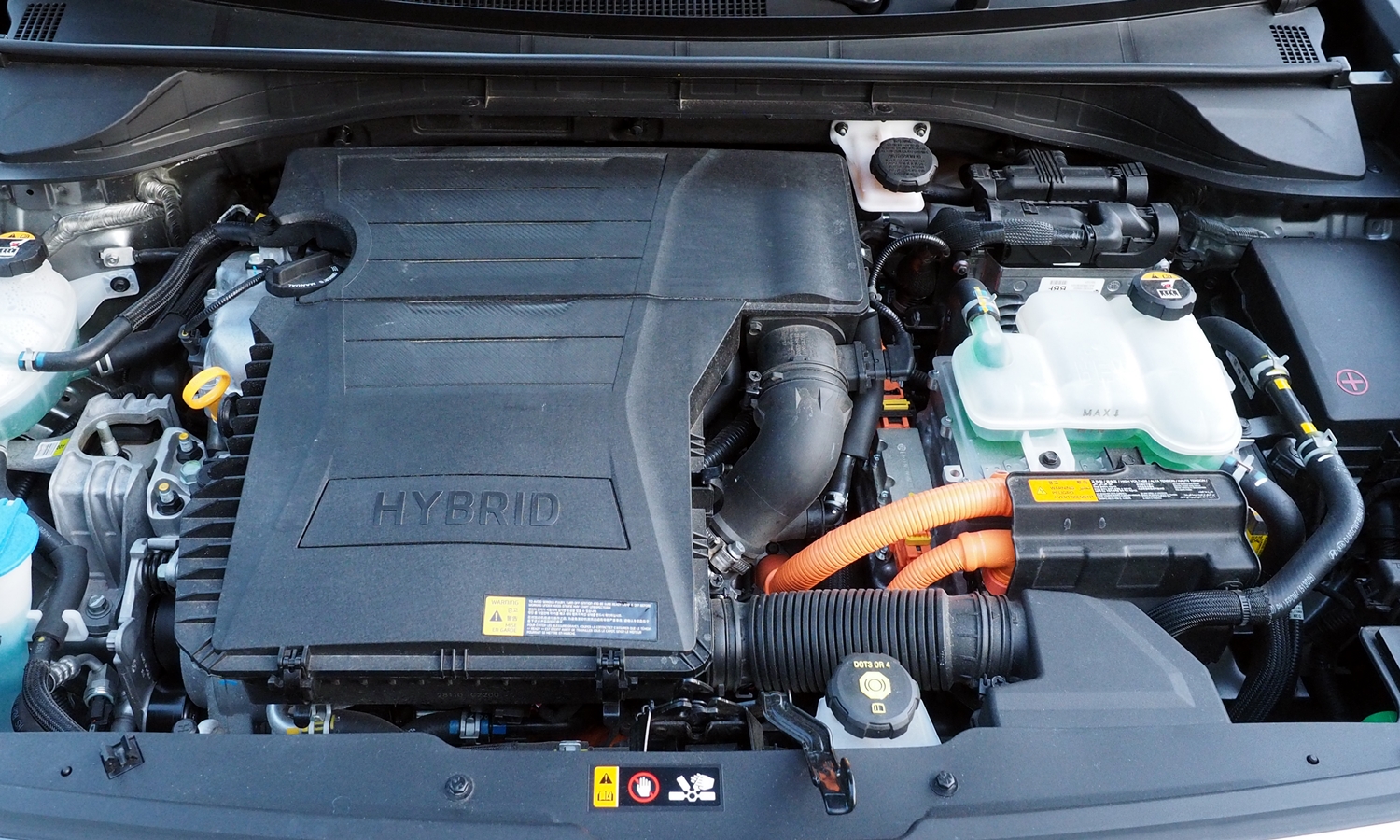
Outstanding fuel economy, decent power, more natural feel than other hybrids.
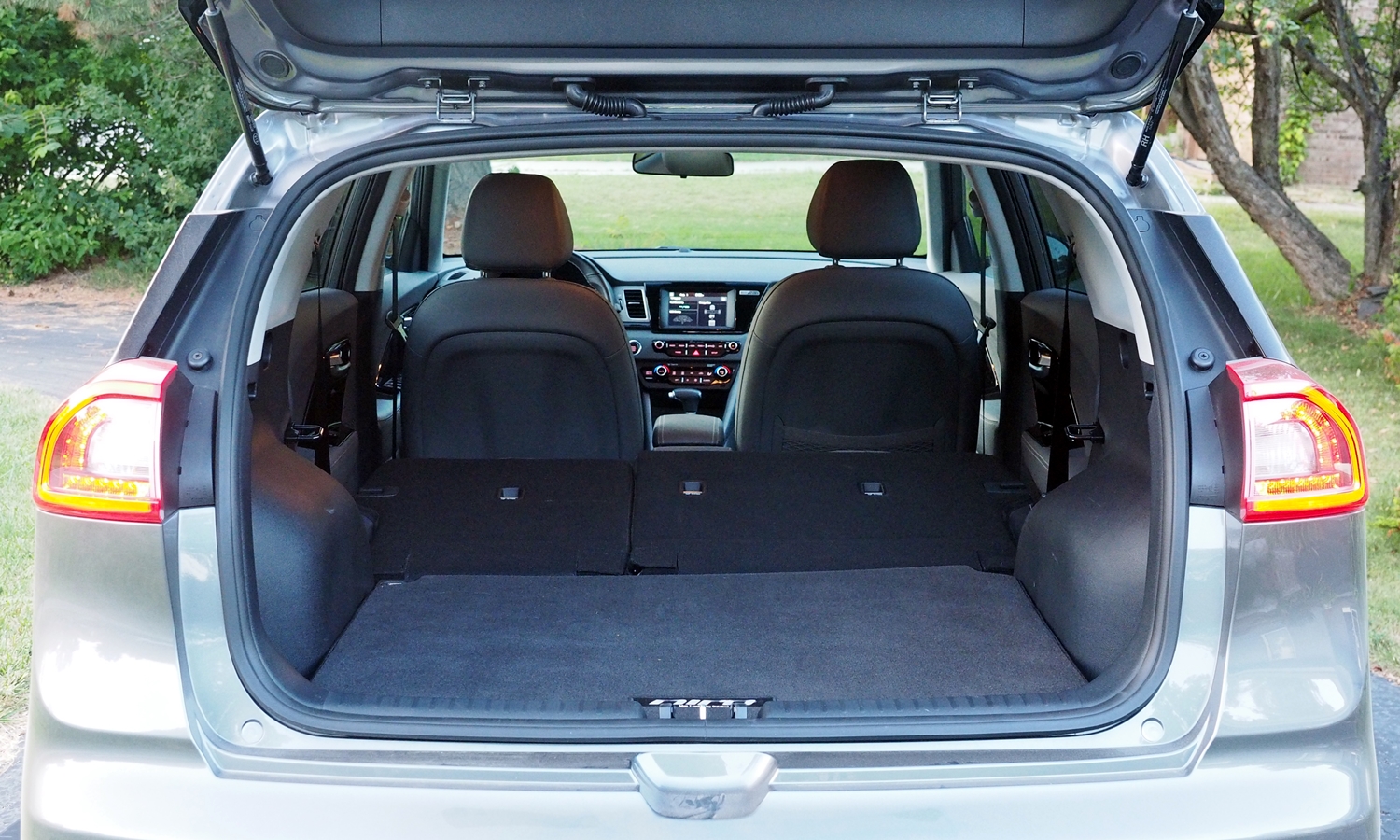
Folding the second-row seat nearly triples the cargo volume.
See more 2017 Kia Niro photos
Kia and Ford provided insured cars for a week with up to a tank of gas. Toyota provided the Prius v at an event for invited media. Lawrence Dixon (248-525-0004) of Szott Toyota in Waterford, MI, provided a RAV4 hybrid for a test drive.











